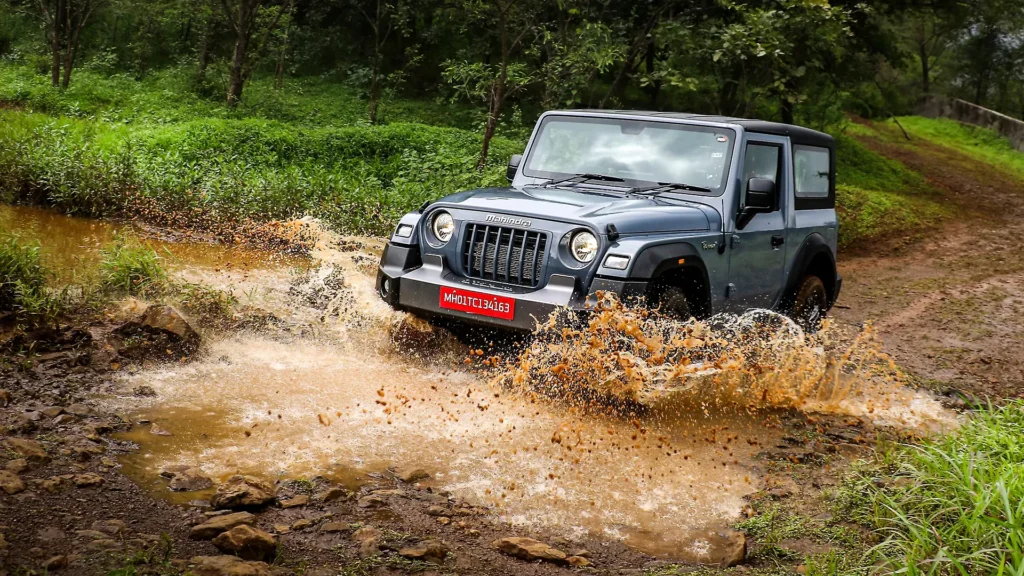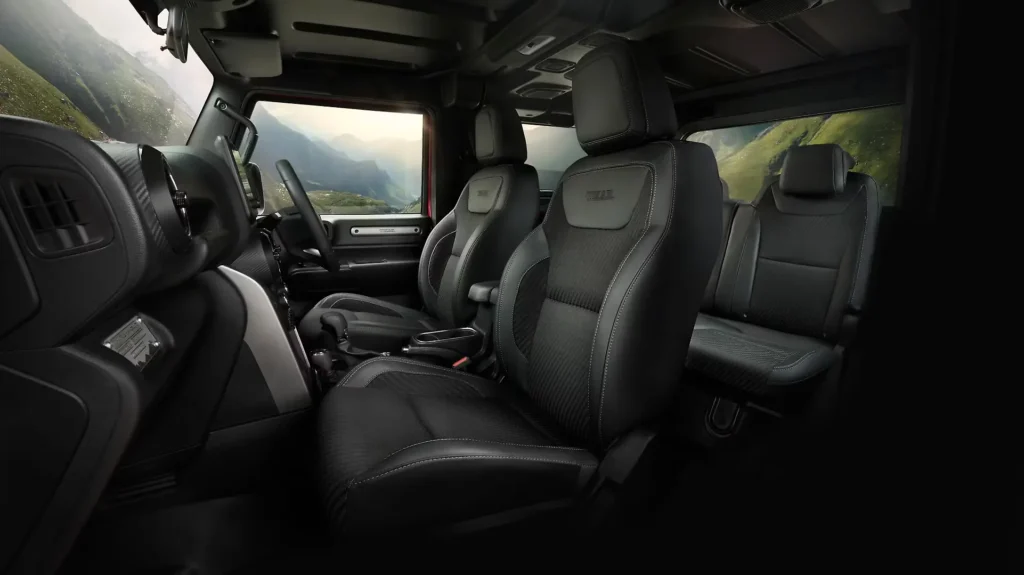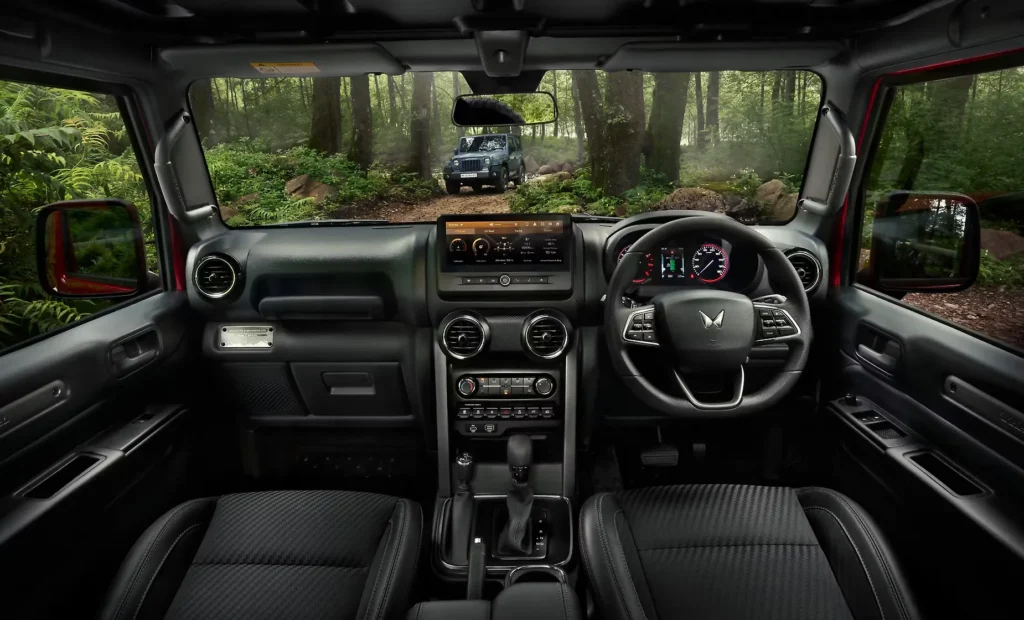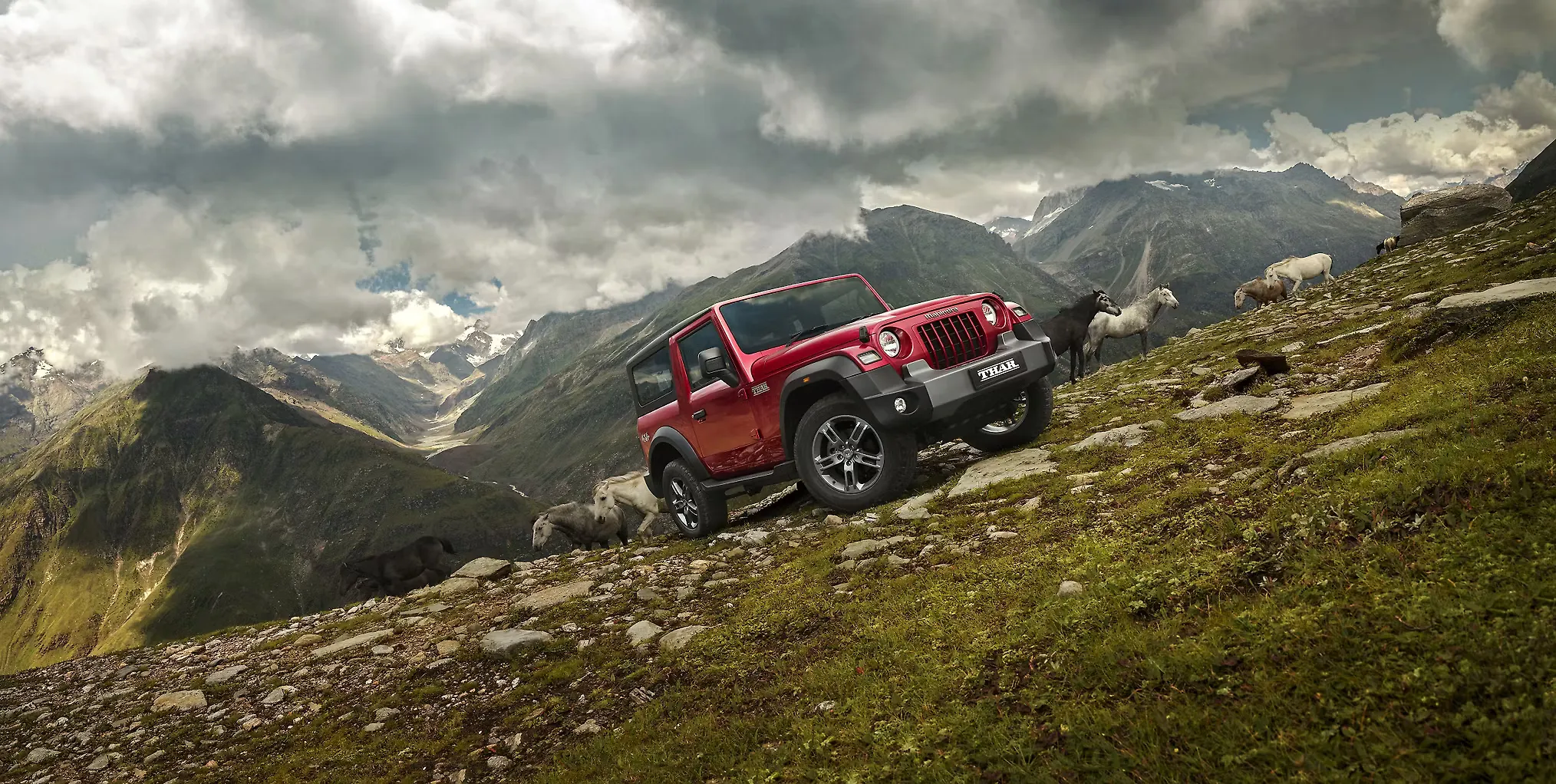The 2025 Mahindra Thar Facelift was launched at Rs. 9.99 lakh (ex-showroom) while the 4WD LXT variant starts at Rs. 15.49 lakh (ex-showroom). The SUV has dual-tone bumpers, a 10.25-inch HD multimedia system, a blacked-out dashboard, rear air conditioning vents, and a modified grille. Three powertrain options are available: 1.5-litre diesel, 2.2-litre diesel, and 2-litre gasoline engines.
Mahindra Thar: Off-roading Capability, Engine, and Ride Quality
The new Thar warriors continue to use the same selection of engines and gearboxes as the original. These consist of 2.0-litre turbo-petrol, 1.5-litre diesel, and 2.2-litre diesel engines coupled with either a torque converter automatic transmission or a six-speed manual gearbox. The bigger mill generates 132 horsepower and 300 Nm, while the smaller diesel motor generates 118 horsepower and 300 Nm. With 150 horsepower and 300 Nm (320 Nm in the AT), the petrol variant is still the most potent of the group. Both the standard 4WD and the RWD are available for city residents, and those on a budget are available. Now that we’ve covered the stats, let’s move on to the important stuff.

When you fire up the Thar, you can immediately see the refining stages. We evaluated the diesel automatic models throughout the day, and the NVH levels were outstanding. Add to it the fact that the gearbox moved smoothly through the gears, and you have something worth appreciating. The power delivery is rather smooth for a diesel, and turbo lag was barely noticeable, if at all. The ride quality is nearly excellent, and we didn’t experience any body roll throughout our brief time with the car, even in fast corners and sprints. The suspension performed an excellent job of absorbing everything that came its way, leaving the passengers in complete comfort.
Entering the slushy pits and emerging unhurt is simply another day for the Thar. Engaging 4-Low shortly before the axle breakers is now a certainty, as the activities become not only more appealing, but also more skill and knowledge-intensive than ever before. Getting into a mud rut may appear to be a straightforward chore, but with one or more wheels hung in the air, it is far from easy.
Juggling over numerous such ruts, watching the beauty of force being transferred to the wheel on the ground, is something that must be experienced firsthand. We also did a little test of its water-wading ability, and the Thar, although being half-buried, made it seem easy. Navigating all of the obstacles was so much fun and involved that we didn’t realise our time at the off-road course was up.
Mahindra Thar: Positioning and Competitors
The Thar, in its three-door form, has always established a niche for itself, and the new version is no exception. While its older sister, the Roxx, continues to be in great demand due to its increased utility, the shorter wheelbase variant is for individuals who actually want to explore unexplored territory while still enjoying the convenience of a smaller footprint.
Mahindra Thar: Exterior
The Thar adheres to it by making modest changes to the external design, some of which are so minor that if you blink, you may miss them. But then again, the Thar has always been a terrific looking car, and the rough, manly attitude and mood it exudes in this market is unparalleled.
The grille design has been carried over from the previous model, albeit it now comes in a body-coloured finish rather than black surrounds and slats. The dual-tone front and rear bumpers, which went AWOL at some point during its career, have returned and, with their brushed aluminium silver finish, assist in underlining its off-road appeal.
The grille design has been carried over from the previous generation, albeit it now has a body-colored finish rather than black surrounds and slats. The dual-tone front and rear bumpers, which went missing at some time during its existence, have reappeared and, with their brushed aluminium silver finish, help to emphasise its off-road appeal.
The side profile stays essentially unaltered. You still receive the grey double five-spoke 18-inch alloy wheels, hefty plastic cladding all around, and a standard antenna located on the left front fender. If you were looking for choices such as a soft-top or a convertible-top, Mahindra will disappoint you, as the hard-top will be the only avatar available owing to a lack of demand for the other variants. One interesting alteration is that the gasoline filler lid no longer has a keyhole. That’s correct, Mahindra has addressed the input and now includes a button below the driver’s side dash that allows you to automatically lift the fuel cover.
The Thar three-door retains features like as a two-step opening boot, squared LED tail lights, bumper reflectors, and a spare wheel located in the tailgate. Those with an eye for detail will note a rear wiper and washer buried under the latter, while the spare wheel now contains the reverse parking camera, a nice touch taken from the Roxx.
Mahindra Thar: Space and Comfort
The way you hop onboard the Thar, as opposed to walking or getting into a vehicle these days, informs you what to expect for the day from the start. The new grab hold on the A-pillar facilitates this movement, and once seated, you’ll see that there’s plenty of headroom and shoulder room. The side bolsters will keep you in position when things become rough, but the thigh support is little.
While most of the ergonomic considerations are correct, charging your phone may be difficult because the cubby allotted for it barely fits the phone, and attaching a charging wire to one end while on the road may result in it shifting about from time to time. The inside has an all-black motif, and while it looks athletic when paired with the imitation carbon fibre texture on the seats, there’s a good risk that the temperatures will get you, especially if you’re sweating in the summer.

Moving back to the second row will be difficult for heavier people, and this difficulty increases if you wish to enter from the driver’s side. However, you will undoubtedly improve over time. While the front passenger seat has a fast lever to adjust it before you hit the back seats, it does not lock in place, which might be an issue if you intend to jump in while the SUV is not parked on a flat surface. The back area is very large, with the sole drawback being a lack of under-thigh support.
Mahindra Thar: Interior
The inside of the revamped Thar is where a greater portion of the upgrades has been addressed. First up is the 10.25-inch HD touchscreen infotainment system, which replaces the previous eight-inch unit. It’s not only the size, but Mahindra has upped the game by giving Gen II adventure and off-roading metrics that display a variety of statistics such as off-road and on-road information, racing gauge, and even a configurable configuration if necessary.

The steering wheel is also new, and aside from the flatter bottom shape, the current and previous units will be difficult to distinguish. Ingress has been simplified by A-pillar-mounted grasp grips, which give much-needed assistance when venturing off the main route. The centre console also undergoes several alterations, the most notable of which is the installation of an armrest. It is adjustable for the driver and has a tiny storage function, which increases the practicality factor. Cup holders are now available, but I wouldn’t chance keeping my coffee in them while the path less traveled is in sight.
They moved the window control switches to the doors, increasing not just functionality but also convenience. Killing two birds with one stone. Yes, and a good one at that. Speaking of convenience, the AT variations now have a dead pedal, which we didn’t notice until it was pointed out, perhaps because we were having so much fun in a true-blue SUV.
While reversing was previously difficult due to the higher-placed back seats and their headrests, paired with the tailgate-mounted spare wheel, this problem has been resolved with the inclusion of a rear-view camera. The clarity of this arrangement is also excellent, and the dynamic guidelines, together with the rear sensors, make life considerably simpler, particularly when backing out of a tight place.

